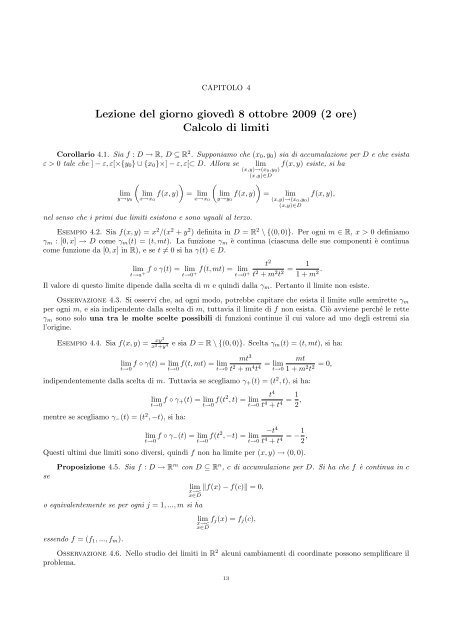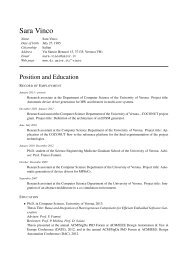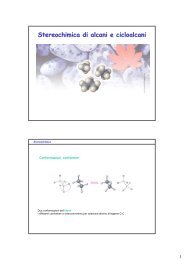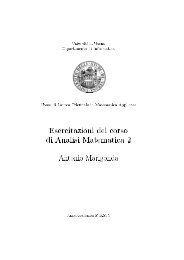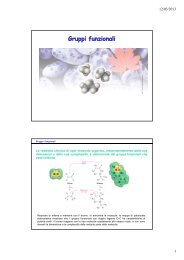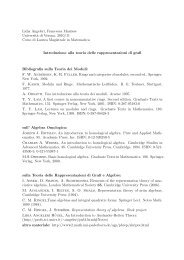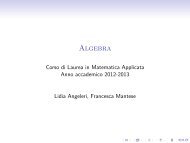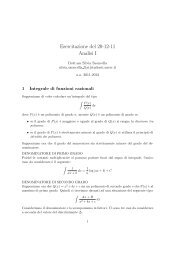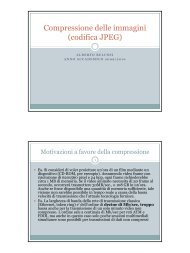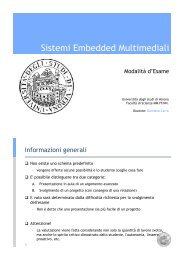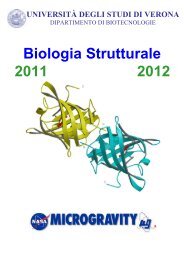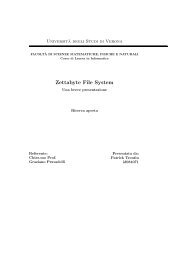Create successful ePaper yourself
Turn your PDF publications into a flip-book with our unique Google optimized e-Paper software.
CAPITOLO 4<br />
Lezione del giorno giovedì 8 ottobre 2009 (2 ore)<br />
Calcolo di lim<strong>it</strong>i<br />
Corollario 4.1. Sia f : D → R, D ⊆ R2 . Supponiamo che (x0, y0) sia di accumulazione per D e che esista<br />
ε > 0 tale che ] − ε, ε[×{y0} ∪ {x0}×] − ε, ε[⊂ D. Allora se lim f(x, y) esiste, si ha<br />
<br />
<br />
lim<br />
y→y0<br />
lim f(x, y)<br />
x→x0<br />
= lim<br />
x→x0<br />
lim f(x, y)<br />
y→y0<br />
nel senso che i primi due lim<strong>it</strong>i esistono e sono uguali al terzo.<br />
(x,y)→(x0,y0)<br />
(x,y)∈D<br />
<br />
= lim<br />
(x,y)→(x0,y0)<br />
(x,y)∈D<br />
f(x, y),<br />
Esempio 4.2. Sia f(x, y) = x 2 /(x 2 + y 2 ) defin<strong>it</strong>a in D = R 2 \ {(0, 0)}. Per ogni m ∈ R, x > 0 definiamo<br />
γm : [0, x] → D come γm(t) = (t, mt). La funzione γm è continua (ciascuna delle sue componenti è continua<br />
come funzione da [0, x] in R), e se t = 0 si ha γ(t) ∈ D.<br />
lim f ◦ γ(t) = lim f(t, mt) = lim<br />
t→a + t→0 +<br />
t→0 +<br />
t2 t2 + m2 =<br />
t2 1<br />
.<br />
1 + m2 Il valore di questo lim<strong>it</strong>e dipende dalla scelta di m e quindi dalla γm. Pertanto il lim<strong>it</strong>e non esiste.<br />
Osservazione 4.3. Si osservi che, ad ogni modo, potrebbe cap<strong>it</strong>are che esista il lim<strong>it</strong>e sulle semirette γm<br />
per ogni m, e sia indipendente dalla scelta di m, tuttavia il lim<strong>it</strong>e di f non esista. Ciò avviene perché le rette<br />
γm sono solo una tra le molte scelte possibili di funzioni continue il cui valore ad uno degli estremi sia<br />
l’origine.<br />
Esempio 4.4. Sia f(x, y) = xy2<br />
x 2 +y 4 e sia D = R \ {(0, 0)}. Scelta γm(t) = (t, mt), si ha:<br />
lim<br />
t→0<br />
f ◦ γ(t) = lim f(t, mt) = lim<br />
t→0 t→0<br />
mt3 t2 + m4 = lim<br />
t4 t→0<br />
mt<br />
1 + m2 = 0,<br />
t2 indipendentemente dalla scelta di m. Tuttavia se scegliamo γ+(t) = (t 2 , t), si ha:<br />
mentre se scegliamo γ−(t) = (t 2 , −t), si ha:<br />
lim<br />
t→0 f ◦ γ+(t) = lim f(t<br />
t→0 2 t<br />
, t) = lim<br />
t→0<br />
4<br />
t4 1<br />
=<br />
+ t4 2 ,<br />
lim<br />
t→0 f ◦ γ−(t) = lim f(t<br />
t→0 2 −t<br />
, −t) = lim<br />
t→0<br />
4<br />
t4 = −1<br />
+ t4 2 ,<br />
Questi ultimi due lim<strong>it</strong>i sono diversi, quindi f non ha lim<strong>it</strong>e per (x, y) → (0, 0).<br />
se<br />
Proposizione 4.5. Sia f : D → R m con D ⊆ R n , c di accumulazione per D. Si ha che f è continua in c<br />
lim f(x) − f(c) = 0,<br />
x→c<br />
x∈D<br />
o equivalentemente se per ogni j = 1, ..., m si ha<br />
essendo f = (f1, ..., fm).<br />
lim fj(x) = fj(c),<br />
x→c<br />
x∈D<br />
Osservazione 4.6. Nello studio dei lim<strong>it</strong>i in R 2 alcuni cambiamenti di coordinate possono semplificare il<br />
problema.<br />
13


